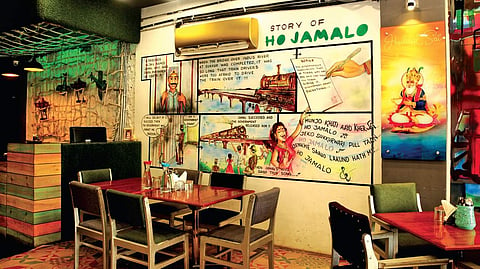

Tucked away on the S G Highway in Ahemdabad is the Sindhi restaurant Hojamalo, named after a 19th century local folk hero called Jamalo Khoso Baloch. Not too happy with his anti-England deeds in the Sindh province, the British sentenced him to death by hanging.
He was held in a jail near Sukkur bridge in Sindh, the largest cantilever bridge in the world at the time, which had then been newly built by the British and was untested.
The government announced a reward for whoever test-drove a train across the bridge. Jamalo wrote to the then acting commissioner about his willingness to shoulder the risk, on condition that he be freed of the charges.
He drove the train across the bridge, came out of jail a free man and his wife sang ‘Ho Jamal Lo’ (a Sindhi folk song) in his honour.
The tale of this popular Sindh folk hero in the form of paintings on a wall greets you when you walk into Hojamalo in Ahmedabad. The drawings are a signature feature of the restaurant, apart from the food, that is.
The Bhajiyas with their ultra-light batter, the crispy Khicha and Kachri, Koki Kali Mirch and Koki Pyas Ki, which are breads with crunchy outer surface and a soft inner layer, can make any Sindhi go nostalgic. For those who are uninititated to the cuisine, the spicy Laccha Phulka and the Bhee Ki Tiki (lotus-stem fritters), which are quite popular in the snacks rack, gives a prompt introduction.
The yummy Dal Pakwan, a hot seller, and yellow Makhni Dal with puri, are specialties one normally does not find in other restaurants. Sindhis have an emotional connect with dishes like Sai Bhaji. Seyal Mani, a pleasant spicy one-dish meal that is a Sindhi staple, and dal sandwich, a take on Sindhi street food, are served here for all foodies to savour.
Everything in the menu—from snacks to chaats to main course—is visually depicted, making it easy for non-Sindhis to pick their poison.
So why a restaurant for an all-Sindhi cuisine? Owner Girish Ramchandani says the restaurant industry has a cold shoulder towards most regional Indian cuisines. “Sindhi food is not available in restaurants of most cities. If people of the community wants to entertain guests, or crave for home food themselves, it is difficult currently to find a place serving Sindhi food. Hence, I decided to start an outlet that specialised in Sindhi cuisine,” he says.
While making the menu, a long and wide search for experts in the cuisine had ended in Sindhi colonies of Ulhasnagar in Maharashtra. “We roped in some women from Ulhasnagar to come and work with our chefs. The menu is a melange of dishes ranging from street food to exotic savouries,” says Ramchandani. “I find people in Ahmedabad being increasingly drawn to other cuisines. People go looking out for Awadhi, South Indian and international foods. The delicate flavours of Sindhi cuisine needs a push.”